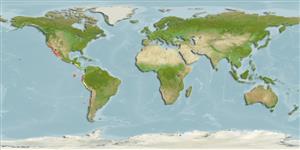Élasmobranches (requins et raies) (sharks and rays) >
Carcharhiniformes (Ground sharks) >
Scyliorhinidae (Cat sharks) > Scyliorhininae
Etymology: Cephaloscyllium: cephalus, from kephale (Gr.), head, referring to its very broad and depressed head; skylion, Greek for dogfish or small shark. (See ETYFish); ventriosum: venter (L.), belly; -osus, Latin suffix connoting fullness, referring to its inflatable stomach. (See ETYFish).
More on author: Garman.
Environment: milieu / climate zone / depth range / distribution range
Écologie
marin démersal; profondeur 5 - 457 m (Ref. 96339), usually 5 - 37 m (Ref. 244). Subtropical; 40°N - 37°S, 126°W - 71°W (Ref. 55293)
Eastern Pacific: central California, USA to the Gulf of California and southern Mexico; central Chile.
Taille / Poids / Âge
Maturity: Lm ? range ? - ? cm
Max length : 110 cm TL mâle / non sexé; (Ref. 96339)
Found on the continental shelves and upper slopes from inshore to deeper waters. Prefers rocky, algal-covered areas of kelp beds. Nocturnal. Feeds on bony fishes, alive and dead, and probably crustaceans. Can inflate its stomach with water or air. Oviparous. Can live in tanks for several years and females can lay eggs in captivity. Occurs in aggregations while resting, sometimes piled one on top of the other. Sometimes caught by sport divers but not used.
Life cycle and mating behavior
Maturities | Reproduction | Spawnings | Egg(s) | Fecundities | Larves
Oviparous, paired eggs are laid. Embryos feed solely on yolk (Ref. 50449).
Compagno, L.J.V., 1984. FAO Species Catalogue. Vol. 4. Sharks of the world. An annotated and illustrated catalogue of shark species known to date. Part 2 - Carcharhiniformes. FAO Fish. Synop. 125(4/2):251-655. Rome: FAO. (Ref. 244)
Statut dans la liste rouge de l'IUCN (Ref. 130435)
Menace pour l'homme
Harmless
Utilisations par l'homme
Pêcheries: sans intérêt; pêche sportive: oui; Aquarium: Aquariums publics
Outils
Articles particuliers
Télécharger en XML
Sources Internet
Estimates based on models
Preferred temperature (Ref.
123201): 14.8 - 28.1, mean 22.3 °C (based on 90 cells).
Phylogenetic diversity index (Ref.
82804): PD
50 = 0.5000 [Uniqueness, from 0.5 = low to 2.0 = high].
Bayesian length-weight: a=0.00263 (0.00139 - 0.00497), b=3.21 (3.04 - 3.38), in cm total length, based on LWR estimates for this (Sub)family-body shape (Ref.
93245).
Niveau trophique (Ref.
69278): 3.9 ±0.61 se; based on food items.
Résilience (Ref.
120179): Faible, temps minimum de doublement de population : 4,5 à 14 années (Fec assumed to be <100).
Fishing Vulnerability (Ref.
59153): High to very high vulnerability (66 of 100).
